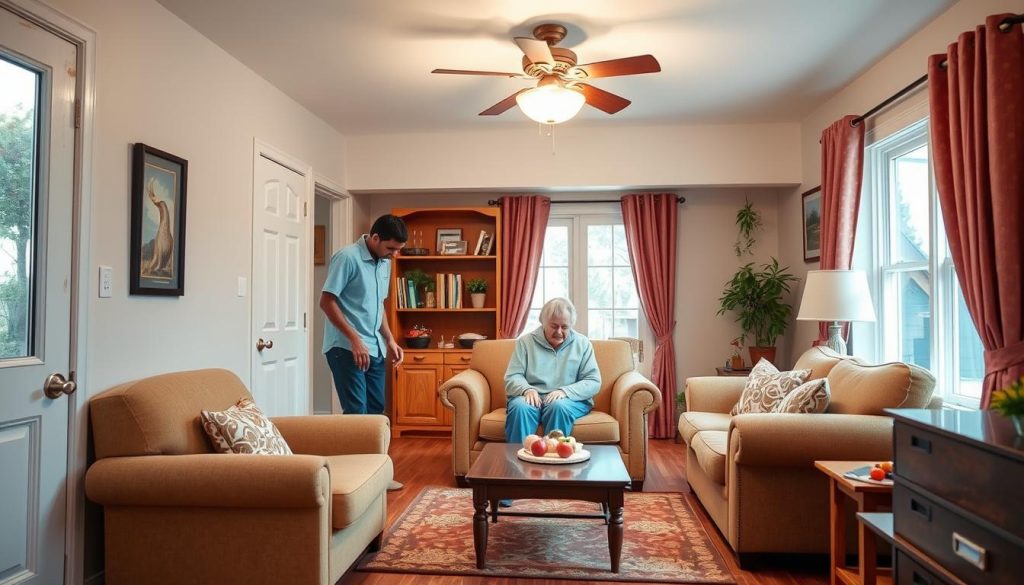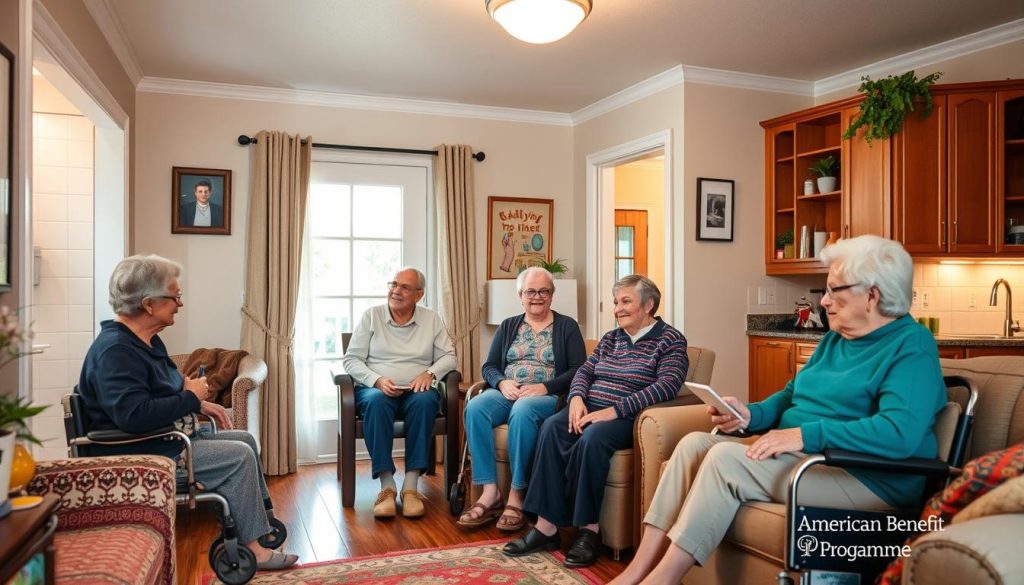Have you thought about your long-term care plans as you get older? It’s important to know about all the care options in the US for you or your loved ones. There are many choices, from care at home to living in care facilities. This article will help you understand these services. It will also show you how to find the best care depending on what you need.
Often, family members, friends, or neighbors provide care at home. This is called informal caregiving1. At home, care might include help with bathing, getting dressed, eating, and managing medicines1. Formal caregivers like nurses can also help at home1. Some services, like getting meals, exercising, and rides, are available in the community1.
If you need more help, there are places you can live that offer care and medical support1. It’s important to know that most insurance, like Medicare, doesn’t pay for this kind of care2. Planning ahead for long-term care is smart. It helps you know what services you can use. It also prepares you to handle the costs of this care12.
Key Takeaways
- Long-term care options range from home-based services to residential facilities.
- Informal caregivers play a crucial role in providing home care.
- Formal caregivers can include trained professionals to assist in home environments.
- Insurance plans, including Medicaid, may cover some long-term care services.
- Proper planning is vital to navigate services and associated costs effectively.
- Eldercare Locator can connect families with local support services.
Understanding Long-Term Care
Long-term care helps people who can’t do everyday tasks on their own. These tasks include bathing, dressing, and eating. More people now need help due to health problems.
Most people with long-term care insurance have seen their costs go up. This has been hard for many families3. Insurance companies are trying to fix this problem. They want to stop these financial challenges from happening again3. You can get long-term care in many places, like your home or a nursing home. Each place meets different needs.
In California, nursing home costs have been going up by more than 5% each year for 20 years4. This means costs could double in just 14 years4. When choosing long-term care insurance, it’s important to know the difference between regular care and medical services. This helps people make good choices.
Who Needs Long-Term Care?
Knowing when someone might need long-term care helps with planning. As people get older, they might face risks that make them need more care. Some risks include getting older, having long-term sickness, disabilities, and sudden health problems like strokes. A key fact is that someone turning 65 has a 70% chance of needing care in the US5. Usually, needing more help happens slowly and changes how much care an older person needs.
People often use long-term care for about three years5. Staying healthy can lower some risks, helping seniors live independently longer. Also, talking early with doctors about health history is key for planning future care needs.
About 52% of older adults pay for their care using their own money6. Usually, families help out for free at first. But, as care needs grow, hiring paid help is needed. Knowing this helps plan for care costs and risks.
| Factors Influencing Need for Long-Term Care | Description |
|---|---|
| Age | Increasing age is a significant risk factor; most individuals require care in their later years. |
| Chronic Conditions | Diseases such as diabetes, heart issues, or cognitive impairments elevate the need for assistance. |
| Disabilities | Physical or sensory disabilities can necessitate long-term support. |
| Health Crises | Unexpected events like strokes or heart attacks can lead to sudden care requirements. |
| Family Health History | Understanding past family health issues can help predict future needs. |
Types of Long-Term Care Services
Long-term care helps people with daily tasks due to age or illness. It includes help at home, services in the community, and residential care facilities.
Home-based care keeps people in their homes with needed support. Families or professionals like nurses help. Services such as home-based care are key for medical needs without moving.
Community care services offer places like day health care and senior centers. They give meals and help people make friends. The California Department of Health Services says many resources help with long-term care needs. This makes finding help easier for everyone7.
Last, residential care facilities have many choices like assisted living and nursing homes. They give help with daily tasks and round-the-clock care. With many types of care, all needs can be met, letting people live happily.
Home-Based Long-Term Care Options
Home-based care lets people get help in their own homes. It supports aging in place. Services vary, including help with daily tasks, meds, and personal care. Care might come from family, pros, or both.
Medicaid helps with home care services. It covers things like personal care and tech aids. The ABD program offers some help, but HCBS Waivers offer more, despite having waits8.
Before choosing home care, a doctor should check what help is needed. Families look at many options to keep loved ones safe at home. Knowing the costs and types of care is key to making good choices.
| Home-Based Care Option | Services Offered | Funding Sources |
|---|---|---|
| Board and Care Homes | Assistance with daily activities, meals, and personal care | Medicaid, personal funds |
| In-Home Care Services | Personal care, medication management, skilled nursing | Private insurance, Medicaid8 |
| Assisted Living Facilities | 24-hour supervision, assistance with daily living | Private pay, long-term care insurance |

Community and Residential Care Facilities
Places like community and residential care facilities are very important for seniors who need different kinds of help. In the United States, about 818,800 Americans live in these care communities. This info comes from the Centers for Disease Control and Prevention (CDC)9. Independent living facilities are great for people over 55 who can take care of themselves but still want some help9. These help seniors stay independent by offering meals at home, rides, and day care programs10.
Assisted living facilities mix personal care and some freedom for residents. They help with things like cooking, cleaning, laundry, and taking medicine9. Nursing homes provide constant nursing care for those with serious medical issues. They make sure patients get professional nursing attention9.
Finding the right place needs looking at many things carefully. You must check on food needs, help with personal care, medicine help, managing health problems, and how much it costs10. Services for memory care have trained staff and special programs for people with dementia10.
Assisted Living Communities: What to Expect
Assisted living is for people who need help every day but not lots of medical care. Most people over 65 will need some long-term care. Assisted living helps keep your independence while supporting you11.
Assisted living offers different things like meals, help with meds, and fun activities. At places like Village Walk in New York, there are over 100 living spaces. They focus on good care11.
Care at assisted living can be light or a lot, called levels 1 to 5. The cost changes with the care level. A one-bedroom can cost $4,885 a month on average11. If you need more help, it costs more each month12.
- Low-care needs fee: $519
- Medium-care needs fee: $1,250
- High-care needs fee: $2,235
- Medication fee: $500
Assisted living checks what help you need. This decides how many people will help you12. Need help with dressing or meds? The cost goes up12.
When picking a place, look at the staff, health care, and rules. If you need special memory care, see if they have it13.
Knowing about assisted living helps families choose. It makes sure loved ones get the right care.
Skilled Nursing Facilities and Their Services
Skilled nursing facilities, or SNFs, are very important. They give full care for people with serious health issues. This includes 24/7 nursing care, help with getting better, and daily living tasks.
Choosing the right nursing home means knowing what they offer and the costs. On average, people stay about five months and it can be pricey. A private room costs around $8,910 a month, and a semi-private one is about $7,800 in 202114. Families need to talk about money and find out if Medicaid can help.
Now, nursing homes have a big problem with not having enough staff. About 60% are struggling with this issue. Nearly 73% are scared they might have to shut down because of it15.
Most nursing homes have many nursing assistants. In fact, 37% of people working there are in this role. The majority of these helpers are women, making up 87% of this group15.
If you’re thinking about nursing facilities, it’s key to pick the right care. These places are great for both getting better and help with daily tasks.
Want to understand nursing care better? Check out this link for more info.
Long-Term Care Options for Memory Care
Memory care services are designed for people who have Alzheimer’s disease or other dementias. You can find these services in places like assisted living communities. These communities have special units for Alzheimer’s care. Laws now require these places to be clear about their fees and services.
Nursing homes offer 24/7 care for people with dementia. They follow strict federal and state rules. Because each place is different, families should look closely at staffing and training before choosing.
Life plan communities offer a range of care levels, from independent living to full nursing home care. This lets residents move to different care levels as needed. It ensures they get the right memory care when they need it.

It’s important to ask about special programs and activities for memory care. Things like cognitive therapy and social activities are key. They help improve life quality by keeping the mind and emotions healthy. Almost 70% of people over 65 will need long-term care at some point. The right support can make a big difference in their life1617.
| Type of Facility | Care Level | Features |
|---|---|---|
| Memory Care Unit | Specialized | Secure environment, trained staff, structured activities |
| Nursing Home | Comprehensive | 24-hour medical care, skilled nursing staff |
| Assisted Living | Supportive | Housing, meals, personal care assistance |
| Life Plan Community | Continuum | Multiple care levels, transition options |
Planning for Your Long-Term Care Needs
Getting ready for long-term care is very important for people and their families. If you’re 65 years old in the US, you have a 70% chance of needing care later on18. Talking early with family members and lawyers makes getting ready easier. A good plan helps families think of possible situations and care options.
Looking at your money is key in this planning phase. Different care types can cost a lot. For example, assisted living costs about $54,000 a year, in-home care is around $61,776, and nursing home care is over $108,0001819. Plus, more than 60% of caregivers lose money at work because of their caregiving, costing them over $7,000 a year19. Knowing these costs is crucial for a solid plan.
Many people don’t realize how much long-term care will cost them. Almost half of the people over 40 have hardly planned for it20. This can cause big problems later, as many expect government help that might not be enough20. Starting to plan early is very important to keep yourself safe in the future.
Paying for Long-Term Care: Financial Considerations
Paying for long-term care can be tough as costs go up. In 2023, the cost for a semi-private room in a nursing facility is about $104,000 a year21. Home health aides can cost up to $75,500 a year, up 10% from last year21. Almost 70% of older adults will need long-term services at some point22.
Savings and pensions are key for paying for care. Long-term care insurance is an option, but only a few older adults have it21. The yearly cost for this insurance is about $1,700 for a 55-year-old man and $2,700 for a woman21. It’s important to know that Medicare usually doesn’t cover long-term care23.
Many find it hard to afford care that could cost $100,000 a year for a nursing home23. About 43% of adults worry they can’t pay for the care they may need as they get older23. This worry leads to 56% of people cutting back on needed items to pay for care23.
Medicaid helps many with long-term care costs. In 2022, it covered about 62% of nursing home costs22. To get Medicaid, people must meet certain income and asset rules, which differ by state22. Understanding these rules can help in planning for elder care.
| Type of Care | Median Cost in 2023 | Annual Increase (% Change) |
|---|---|---|
| Semi-Private Room in Nursing Facility | $104,000 | 4.4% |
| Private Room in Nursing Facility | $116,800 | 4.9% |
| Home Health Aide | $75,500 | 10% |
| Assisted Living Facility | $64,200 | 1.4% |
| Homemaker Services | $68,600 | 7.1% |
Conclusion
Looking into care options for the future is key for people and their families. As more folks reach 65 in the U.S., it’s crucial to know what you need and what help is out there24. About 58% of folks needing care are over 65. They may need help at home or a nursing place25.
Planning helps match care to changing needs. For example, more than 31% of those 85 and up need help with daily tasks24. Long-term care insurance is also important. It pays for care that regular health insurance doesn’t. It’s best to look into it when you’re in your mid-50s to mid-60s26.
Starting to plan early makes life better for older adults and their families. By keeping care plans updated, everyone stays ready for what may come. This helps create a caring and safe space for aging and health issues.
Source Links
- What Is Long-Term Care?
- Long-term care
- Understanding Long-Term Care Insurance
- Long Term Care Insurance
- Long-term care costs & options | Fidelity
- Paying for Long-Term Care
- Long-Term Care
- What is Long Term Care at Home and Does Medicaid Pay for It?
- Different Types of Long-Term Care Facilities Explained
- Long-Term Care Choices | Kaiser Permanente
- Unpacking Assisted Living: The 5 Levels of Care in Assisted Living
- Understanding Assisted Living Levels of Care
- How To Choose a Nursing Home or Other Long-Term Care Facility
- Long-Term Care Facility vs. Nursing Home: 5 Key Differences
- Long Term Care and Skilled Nursing Facilities
- Long-Term Care
- Does Long-Term Care Insurance Pay for Memory Care?
- Planning for Long-Term Care
- How long-term care planning can help your loved ones | Fidelity
- An Action Plan for Long-Term Care
- How to Pay for Long-Term Care
- 7 practical ways to pay for long-term care
- The Affordability of Long-Term Care and Support Services: Findings from a KFF Survey | KFF
- An overview of long-term care
- Profile of Long-Term Care – Improving the Quality of Long-Term Care
- What Is Long-Term Care and How Does It Impact Medical Insurance? | Decent





















